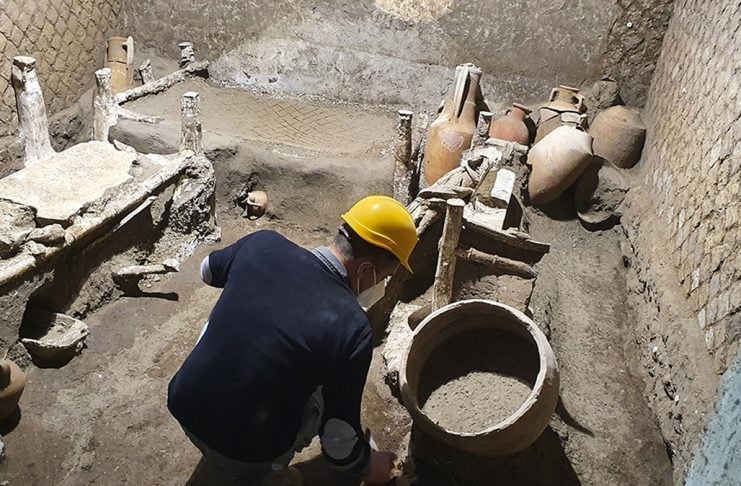
A team of archaeologists working at the Archaeological Park of Pompeii on Monday has discovered the ruins of a room in which slaves once lived.
Pompeii was an ancient Roman city that existed in what is currently known as Campania, Italy. The city was famously destroyed by a volcanic eruption that occurred in 79 AD from Mount Vesuvius. Pyroclastic flows of volcanic ash and other fallout descended on the city, its inhabitants, and its buildings, leaving most of Pompeii hidden for almost 2,000 years.
Because of the scale of the volcanic eruption, archaeologists are always unearthing new relics from the site. A team has just recently discovered a room in which they believe slaves lived, identifying different plaster containers, wooden sleeping arrangements, and other artifacts that indicate the life common to those living in the city at the time.
Director-General Gabriel Zuchtriegel explained that: “The archaeology helps us to discover a part of the ancient world which we would otherwise know little about, but which is nonetheless extremely important. What is most striking is the cramped and precarious nature of this room, which was something between a dormitory and a storage room of just 16 square meters (172 square feet), which we can now reconstruct thanks to the exceptional state of preservation created by the eruption of AD 79.
“It is certainly one of the most exciting discoveries during my life as an archaeologist, even without the presence of great ‘treasures’ – the true treasure here is the human experience, in this case of the most vulnerable members of ancient society, to which this room is a unique testimony,” Zuchtriegel said.
Archaeologists unearth artifacts that illuminate ancient world of Pompeii
Another fascinating discovery made in late 2020 by archaeologists working in Pompeii: the remnants of an ancient street food shop.
Experts unearthed an entire food shop that sold ready-to-eat meals to passersby, in what appears to be a proper street food shop, equivalent to our modern-day fast food.
The archaeologists found counters containing circular holes, where terracotta jars with food had been stored by the shop owner.
Additionally, these counters feature fantastically well-preserved, vividly-colored frescoes depicting different animals, most likely telling customers about the kind of meat that was sold in this shop.
Following further analysis, archaeologists found traces of beef, pork, fish, and snails, revealing the variety of dishes the residents of this Greco-Roman city were enjoying.
The information discovered during the dig is crucial to developing our understanding of life in antiquity.
A skeleton discovered in early August in Pompeii also proves that Greek culture was thriving in ancient Rome.
The discovery was made in the necropolis of Porta Sarno, an area not yet open to the public, located in the east of Pompeii’s urban center.
A skull bearing tufts of white hair and part of an ear, as well as bones and fragments of fabric, were found in the tomb. It has been described as “one of the best-preserved skeletons ever found in the ancient city.”
An inscription on the dead man’s tomb identifies him as Marcus Venerius Secundio; incredibly, it appears to indicate that he helped stage performances of Greek plays. It says the deceased “gave Greek and Latin ludi,” or performances.
Performances in Greek at Pompeii
“It is the first clear evidence of performances at Pompeii in the Greek language,” Gabriel Zuchtriegel, director of the Archaeological Park of Pompeii, said in a statement. “That performances in Greek were organized is evidence of the lively and open cultural climate which characterized ancient Pompeii.”
Wax tablet records kept by Pompeian banker Cecilius Giocondu note that Secundio was enslaved and served in the Temple of Venus. But he rose through the social ranks once he was freed, joining the Augustales priesthood, an imperial cult. Secundio died around the age of 60, buried in a large and impressive tomb befitting his improved social status.
See all the latest news from Greece and the world at Greekreporter.com. Contact our newsroom to report an update or send your story, photos and videos. Follow GR on Google News and subscribe here to our daily email!



